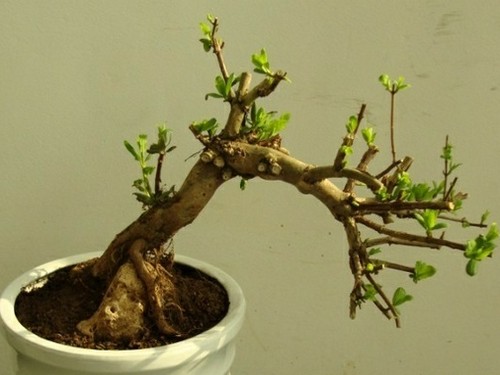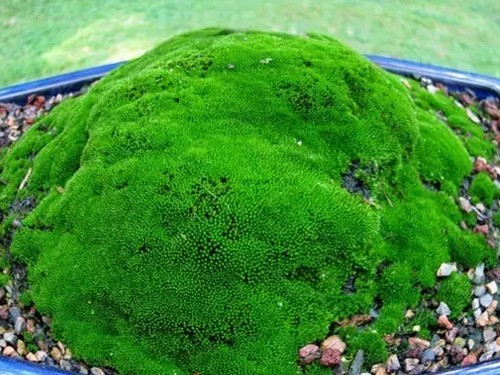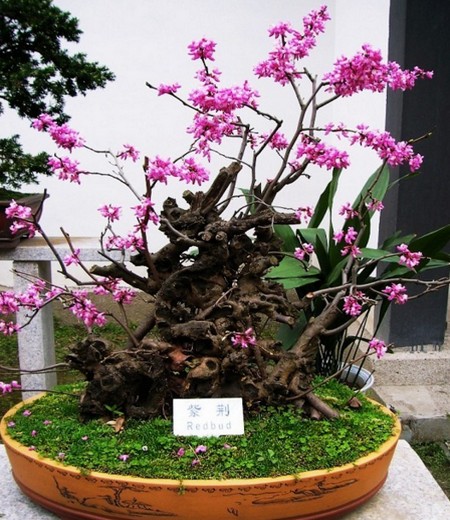How to make bonsai of honeysuckle
Honeysuckle is a temperate and subtropical tree species, which is sunny, shade-tolerant, cold-tolerant, drought-resistant and moisture-tolerant, and can adapt to acid and alkaline soil, but it likes loose and fertile neutral sandy loam. It is a good material for bonsai production because of its strong nature, developed root system, strong sprouting ability, light plant, graceful posture and elegant old pile.

Methods / steps
I. the source of the tree stump
1. Sow and reproduce. The ripe fruits were harvested from August to October, the pericarp was washed with clean water, the seeds were harvested and dried, and then stored in a cloth bag at low temperature to the next spring. Sowing seeds from late March to early April, soaking seeds in 25 ℃ warm water for one day before sowing, then mixing wet sand into cloth bags and putting them indoors, heat preservation with rice straw (straw, thatch, etc.). When the seeds of more than 1 stroke 3 are exposed, they are sown in loose, fertile and well-drained sandy soil, and seedlings can emerge about 10 days after sowing. It was transplanted to the nursery in the spring of the following year and was generally cultivated in the pot after sowing for 5 years.
2. Cuttage propagation. In the middle and last ten days of June, the full semi-lignified branches of the same year were cut as cuttings, each section was about 15~20cm long, and the bed soil was kept moist. I sprayed the cuttings, and it took about 25 days to take root. It was transplanted to the nursery in the spring of the following year and cultivated in the pot 4 years later.
3.Propagation of individual plants. In spring and autumn, the seedlings sprouting from the roots of the mother plant were dug up (separated by a sharp knife) and transplanted to the nursery with roots, which could be cultivated in pot for 4 years.
4. Striping propagation. In spring and autumn, take the longer branches of the mother plant and bury them in the soil for about 5cm, deep 2~3cm, keep the soil moist, take root in the same autumn, separate them from the mother plant in the nursery in the next spring, and cultivate them in the pot after 3 years; or select the vigorous and elegant branches in the Meiyu season for high pressure, cut off the mother plant and cultivate in the pot directly after rooting, this method takes faster forming time.
5. Mountain mining. Honeysuckle is rich in wild pile resources, and it is suitable to dig the sturdy, strange and twisted old piles in the mountains in early spring, which can achieve the effect of rapid prototyping. The method of mining is to first cut dry and store branches, properly trim the aboveground parts, retain one or two main branches, then peel off the topsoil, find out the growth direction of the main root, and dig patiently and meticulously along the trend of the main root. This is conducive to root protection and reduce damage. After the stump is dug up, put it in a cloth bag and soak it in water (or cover the roots with wet straw, bushes, cloth, moss and other materials), and then transport it back to planting.
II. Cultivation of Honeysuckle stump
Honeysuckle is strong in nature, it can take root as soon as the stem hits the ground, and the bare root can be transplanted, and the excavated old pile is easy to survive without fibrous root.
1. Pruning the root. The root system of honeysuckle stump dug out in the mountain or nursery is often very long, so don't rush to cut it short when you cultivate it, you should carefully observe the idea. The roots can often be shaped to replace dry roots, and then according to the size of the pot, cultivation needs, properly trim the roots, and then plant in the pot, do not bend the thick roots too hard or by a large margin to prevent breaking. In this way, after forming, it is intertwined and very pleasing to the eye.
2. Pruning branches. Honeysuckle wild in roadsides, hillside bushes or sparse forests, is a climbing plant, like winding, often in a spiral on nearby strips (such as trees, branches, etc.), often with leaves at the tail. Therefore, most of the old piles dug back are leafless and there are not many branches, only useless branches, weak branches, disease and insect branches need to be cut off, and the main branches need to be appropriately truncated according to proportion and shape. The tree stump dug in the nursery has been cultivated for many years, and its branches and leaves are more exuberant. It is necessary to properly cut the branches and leaves to make them dense and orderly, in line with nature and rich in painting.
3. Pruning post-processing. Honeysuckle stumps are generally transplanted without soil masses. After pruning the roots and branches, it is best to soak them in water for 1 hour or 2 hours, let them absorb enough water, speed up the germination of new roots and buds, then smear the branch wound with white latex, dip the root wound with a new brush dipped in 0.3% potassium permanganate solution, and then plant it in a pot.
4. Put on the pot. Honeysuckle is not demanding on soil, but it is best to use mountain mud or mainly mountain mud plus an appropriate amount of rotten leaf soil, coal ball ash and so on to prepare culture soil. The suitable time for potting is early spring. Cliff type, hanging branch type honeysuckle bonsai should be equipped with quaint and graceful bonsai, which is conducive to the loose drape of branches and graceful appearance; curved dry honeysuckle bonsai should be matched with shallow round (oval) or rectangular pottery basin or glaze basin. When putting on the basin, wash the selected basin first, then use 2-3 pieces of broken tiles (basin) to cover the drainage hole, and the high and deep basin should also use industrial slag (or tiles, small stones, etc.) to cushion the lower layer, then fill it with culture soil and plant it into the tree stump. The depth and location of planting should be determined according to the needs of the pot and the type of plant. After planting, the pot is covered with moss or planted with grass such as Cuiyun grass, coriander, paving grass, and Dichondra, which can be embellished and moisturized, and then move to a semi-shaded place to keep the basin soil moist, often spraying water on tree stumps and branches. Full sunshine management can be carried out after one month, but the times of watering and spraying should be increased, generally watering 2-3 times and spraying 4-5 times on the first day.
5. the type caused by processing. The styling of the stump should be based on the six meanings of wood and the art in accordance with their aptitude. Honeysuckle is generally suitable for root-lifting bonsai, which can be planted with roots when potting; or when turning the basin, the roots can be lifted up year by year; the stump that has been planted in the deep basin for many years can also be removed from the pot soil at the same time, do not break the soil and hurt the roots, and be planted in a shallow pot slightly larger than the deep basin, fill the gaps around with nutritious soil, and wash away the soil between the roots above the basin with a faucet after the pier is filled, and the excess hairy roots will be cut off after showing the roots. Honeysuckle bonsai modeling is mainly cliff type or hanging branch type, which can show its natural dynamic posture incisively and vividly. Because of the left entanglement of its stem, its stem can also be shaped by curved stem, and the method of pruning should be used, but too many times of pruning in one year should be avoided, otherwise it will affect the formation of flower buds. For the branches that are not in place, moderate iron wire can be used for flat binding and traction, and the iron wire should be released in time after the branches are turned to Lignification and setting. The natural style is used to make the branches on the pile let nature take its course, droop smoothly, and the branches and leaves are dense and dense, and the blank is used reasonably to make it rich in painting and increase the beauty of art.
Although honeysuckle has all kinds of pile heads in nature, there are not too many suitable for making bonsai, so we should try to choose stumpy roots, stout, vigorous and simple, curved changes, short and compact tree shapes, thick and short internodes, and natural tree stumps.
Techniques for making bonsai of honeysuckle:
1. Control water and fertilizer: honeysuckle pot cultivation must limit the growth of vines, control the shape of trees and increase the number of flowers. Avoid the rain in spring, reduce watering, prevent excessive growth, make the stem mature, shorten the internodes and dwarf the plant shape. Little or no nitrogen fertilizer was applied before flower bud formation, but phosphorus and potassium fertilizer was increased to promote flower bud formation and increase flower quantity. The branch stops the growth period, the bud stage appropriate application of nitrogen fertilizer, so that the flowers are big and gorgeous.
2, appropriate time to change pots: general potted flowers change pots once a year or two, and honeysuckle bonsai change pots once every three or four years. Due to the few times of changing pots, it weakens the absorption function of roots, promotes plant aging, inhibits overgrowth, relaxes tree potential, promotes sturdy vines, dense internodes, dwarfing plants and luxuriant flowers.
3. Growth inhibitor shoot control: when the branches of honeysuckle sprouted about 5cm, they were sprayed or poured with paclobutrazol from 700cm to 1000ppm, or paclobutrazol from 2000 to 4000ppmb9, or dwarfing from 1000 to 2000ppm, for several times to inhibit the growth of stems and dwarf the shape of trees.
4. Dwarfing, shaping and pruning: from the beginning of pot planting, dwarfing, shaping and pruning was carried out and cultivated into thick, dry and short branches. During the growing period, remove the buds with exuberant growth, pick the hearts of the strong branches early, and keep them short when pruning. Through shaping and pruning, the pile scene of short shrub with short branches, uniform and dense branches and obvious layers can be changed from the winding type of vines to the short shrub type.
5. Long-day treatment: honeysuckle is a light-loving and long-sunshine plant. If the environment is ventilated and damp, the stems will grow too long, the branches will be thin and weak, the leaves will yellowing and fall off easily, and the flowers will bloom less. Therefore, honeysuckle bonsai should be placed in a sunny place, and it is best to have direct sunlight throughout the day to promote sturdy and short branches, leaves and flowers, and prolong the flowering period.
6. Processing: the shape of honeysuckle is mainly climbing and pruning. Climbing and binding the main branches together and weaving them into a trunk so that they can grow into a whole for further processing. Twigs are generally processed by pruning.
7. Tree shape: there are mainly oblique dry type, curved dry type and cliff type, and the roots are exposed gradually. Most of the twigs are made into a drape to show their natural characteristics. In addition, honeysuckle can also be made into stone-attached bonsai.
Note that honeysuckle because of its larger branches, although the stem is vigorous and simple, but the branches are extremely brittle, easy to break and rot, and larger branches, do not easily change their shape and angle, let alone like making other miscellaneous wood bonsai. To distort the shape and angle of the trunk and branch.
Time: 2019-05-26 Click:
- Prev

The steps of making moss bonsai
Today, moss bonsai has been well cultivated, as a very special plant, its high survival rate and many other characteristics, but during the cultivation period, we should pay special attention to the invasion of other higher plants, so in any case, the cultivation process of moss bonsai plants is also the most important. What about
- Next

Production method of Bauhinia bonsai
Bauhinia its spring purplish red flowers bloom in the first leaves, shaped like butterflies, when in full bloom, close to the branches, the tree is full of flowers, not only on the branches, but also the old trunk, even the trunk close to the root can also bloom. After the defoliation in winter, the branches show their muscles and bones, and the feeling of vigorous Qiu qu is suddenly in front of us. Use it to make bonsai.
Related
- Fuxing push coffee new agricultural production and marketing class: lack of small-scale processing plants
- Jujube rice field leisure farm deep ploughing Yilan for five years to create a space for organic food and play
- Nongyu Farm-A trial of organic papaya for brave women with advanced technology
- Four points for attention in the prevention and control of diseases and insect pests of edible fungi
- How to add nutrient solution to Edible Fungi
- Is there any good way to control edible fungus mites?
- Open Inoculation Technology of Edible Fungi
- Is there any clever way to use fertilizer for edible fungus in winter?
- What agents are used to kill the pathogens of edible fungi in the mushroom shed?
- Rapid drying of Edible Fungi

